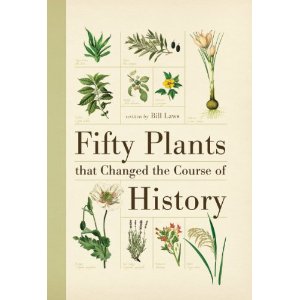 Bill Law’s book, Fifty Plants that Changed the Course of History is a great read for those who love plants and history. It is filled with interesting tidbits and morsels of information about familiar plants as well as more exotic ones. Guaranteed, however, there will be some new and quirky facts you will learn on every plant you read about, familiar or not. Every entry contains something to spark your curiosity and spur you on to read the next one.
Bill Law’s book, Fifty Plants that Changed the Course of History is a great read for those who love plants and history. It is filled with interesting tidbits and morsels of information about familiar plants as well as more exotic ones. Guaranteed, however, there will be some new and quirky facts you will learn on every plant you read about, familiar or not. Every entry contains something to spark your curiosity and spur you on to read the next one.
Beginning with agave (Agave spp.) and ending with ginger (Zingiber officinale), the book presents the plants in alphabetical order by botanical name. Each entry focuses on the significant uses of the plant and presents anecdotal descriptions that are entertaining as well as informative. You learn how margarita cocktails were invented, why the English serve tea in china pots, and the identity of Johnny Appleseed.
Insets in each entry provide additional facts about the plant or related topics. One such inset tells us how koala bears need fire ants to keep their food supply available. Another explains that white bread developed in the 1700s because of a growing addiction to sugar than made people unable to digest whole grain wheat. A third reminds us that Fidel Castro, son of a wealthy sugar landlord, seized power with the help of a bad economy caused by the dwindling demand for Cuban sugar.
Numerous illustrations such as prints, paintings, sculpture, photographs, and print media adorn every entry and the captions provide additional details about the plant. A painting from ancient Santorini suggests that crocus stamens were harvested as early as 1600 BC. When Jean Nicot present tobacco plants to Queen Catherine they were thought to be a great healing plant. A photograph of the tree that is said to have sheltered Robinhood is called the Major Oak and is 33 feet in girth.
Quotes from famous authors, painters, writers and similar notables add a different touch to the entries. Pierre-Auguste Renoir wrote to a friend about the brutish olive tree that was difficult to paint. Thoreau, on the other hand, cherished beans and considered hoeing them a day’s work. Sadly, writer Richard Sudell noted in 1937 in his garden dictionary, that the tobacco was the most universally loved plant.
Many different emotions may arise as you read the stories of the people who enjoyed, profited, or were harmed by the fifty plants described. You can’t help but feel sympathy for the English opium addict that wrote that his drug of choice held the keys to Paradise, or the Irish that suffered during the potato famine. On the other hand, reading about the English preferring parsnips to potatoes because they considered the latter a sign of popery, is bound to spark a different feeling. No matter what plant, the material the authors chose to present is informative and entertaining. Laws reminds us, however, that of the 3,000 plants mankind has used for food in the past, only about 20 species feed most of the people in the world. We are taking liberties with our plants, he warns, and unless we change our ways we could alter the course of history forever.
To buy Fifty Plants that Changed the Course of History from Amazon.com click here.